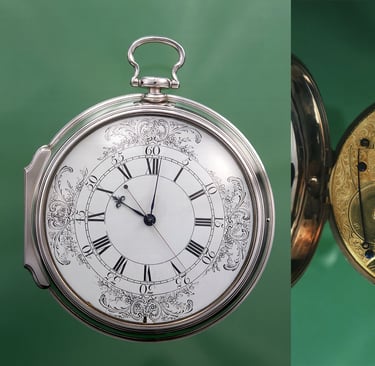Marine Chronometer🌊⛵ Modern Timekeeping
Stories About Time: Measuring Moments Through History ⏳🌞🌕 from the chapter "Towards an Understanding of Linear Time" from the History Album. In this chapter we invite children to a journey through the fascinating evolution of timekeeping. Starting with observing the Sun🌞, and people who first noticed the movement of shadows to mark the day, to the people who noticed the phrases of the Moon 🌙, and tracked the lunar cycle to create months, these stories uncover humanity’s inventive ways of measuring moments.Children will marvel at ancient innovations, like sundials and lunar calendars, and explore cultural contributions, such as candle clocks 🕯️ and water clocks 🌊, that paved the way for modern timekeeping. Each story weaves history, science, and culture, showing how humans connected with the natural world to organize their lives. 🌿✨Through these narratives, children will see time not just as a number on a clock, or passing month on the callendar, but as a rich legacy of human curiosity and creativity. With hands-on activities like building sundials and journaling moon phases, they’ll become modern-day timekeepers, inspired to ask, “How did people measure time before clocks?” and “What can I discover about time?”This vivid exploration links the past to the present, sparking imagination and a deeper appreciation for the ingenuity of those who came before us. 🌍✨
HISTORY STORIES
12/18/20243 min read


Do you remember how pendulum clocks worked beautifully on land 🕰️, but turned wobbly on rocking ships ⛵? Imagine this: you’re a sailor crossing vast, unpredictable oceans, your ship rocking with the waves 🌊⚓. The pendulum inside your trusty clock starts swinging wildly—tick, tock, sway, wobble. Pretty soon, it’s not ticking, it’s tocking… and you’ve completely lost track of time. Chaos!
Sailors needed a clock that could keep steady time, no matter how stormy the sea or rough the journey. And then came someone extraordinary—a carpenter with a passion for gears and a dream to solve the unsolvable. Meet John Harrison, the genius who dared to create a clock that laughed in the face of ocean waves! 🌟🛠️
John Harrison wasn’t your typical inventor. Born in England in 1693 🇬🇧, he wasn’t a scholar or a scientist—he was a carpenter, someone who worked with wood, hammers, and saws 🛠️.But Harrison wasn’t just building tables and chairs. No, he was building dreams. He loved clocks and spent hours tinkering with gears and mechanisms, making each one more precise than the last. If something didn’t work, he didn’t give up—he just tried again, and again, and again.⚙️
Over 300 years ago explorers were sailing across the globe 🌍, discovering new lands, trading spices, and charting maps. But without a reliable way to measure time at sea, sailors often got lost. Ships went off course, and entire voyages ended in disaster. “We need a clock that works at sea!” they cried. The government even offered a huge prize—a king’s fortune! 💰
Harrison, with his clever mind and a dash of audacity, thought, “Why not me?” So he got to work.
He started with his first sea clock, H1. in 1735. In case you wonder, “H” stands for Harrison. And this clock was a marvel! It looked nothing like the elegant clocks you might imagine. It was big, bold, and full of springs and gears. And guess what? It worked! 🛳️ The H1 kept steady time even as ships rocked and swayed. But Harrison wasn’t satisfied. “Good,” he thought, “but I can make it better.”
He didn’t stop there! Harrison kept improving his design, creating smaller and more accurate versions—H2, H3, and finally, the masterpiece, H4. H4 wasn’t just a clock with winding crank—it was a pocket watch-sized wonder!Sailors could now measure time accurately on even the stormiest seas 🌊. It helped them figure out their longitude (their position east or west) and navigate the oceans with confidence.
🌊✨ After years of trial, error, and brilliance, Harrison built H5, his fifth and final marine chronometer in 1770. Unlike his earlier, larger designs, H5 was smaller, lighter, and even more accurate. It looked less like a clock and more like a large pocket watch—but with all the precision a sailor could dream of! ⏱️⚓
People named this pocket watch marine chronometer, 👏 Chro 👏 nom 👏 e 👏 ter! 👏 The name “marine chronometer” combines “marine”, from the Latin marinus meaning “of the sea,” and “chronometer”, from the Greek chronos (time) and metron (measure), together meaning “a time measurer for the sea.” 🌊⏱️✨
It could measure time down to the second, calculate sailors longitude, and pinpoint their location at sea with incredible accuracy. Harrison’s invention saved countless sailor lives and made exploring the world safer. It’s no wonder the British government awarded him the Longitude Prize for solving one of the greatest challenges of his time. 🏆✨
💭 Can you imagine sailing across the ocean, using nothing but the stars and a tiny clock to find your way? Harrison’s marine chronometer was like a GPS for the 18th century, proving that even the wildest seas couldn’t stop human creativity and curiosity to explore.
But timekeeping didn’t stop here. Scientists and inventors kept asking, “What if we could measure time even more precisely?” That question led to another groundbreaking invention—the quartz clock. What made it so special?
That’s a story for another day… ⏱️✨
This story is part of the following Clock Stories Series which can be turned into Drama Play or Storybook Compilation.
Ancient Timekeeping
🌞 The Sundial ~3500 BCE
🌊 The Water Clock ~1500 BCE
🏛️ The Tower of the Winds ~50 BCE
Medieval Timekeeping
🕯️ The Candle Clock ~980 CE
🌌 Su Sung’s Astronomical Water Clock ~1092 CE
⏳ The Hourglass Sand Masters ~14th Century
🛎️ The Mechanical Church Bells ~14th Century
Science in Timekeeping
🌟 Astronomical Marvel: The Prague Clock ~1410 CE
🌍 Galileo’s Pendulum Discovery ~1602 CE
Modern Timekeeping
With Montessori joy,
Vanina 😊

